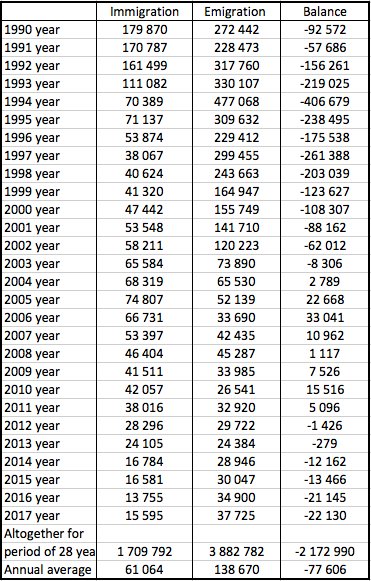On June 22, 2019, it will be exactly 30 years since Nursultan Nazarbayev has become the country’s leader — first, as the First Secretary of the Central Committee of the Kazakh Soviet Social Republic’s Communist Party, then, as the President of the Kazakh Soviet Social Republic inside the USSR and, finally, as the President of the sovereign and independent Republic of Kazakhstan. A lot has happened during these years both the good and the bad. And, it seems the time has come to review the results of this period.
Let us try to do so by using the external migration statistical data. Of course, the emigration from Kazakhstan is an exceptionally complex process influenced, among other things, by
- the collapse of the socialist system and the disintegration of the USSR that had led to the massive-scale emigration of citizens of many ethnicities to their ancestral lands;
- the collapse of the socialist economy as such and its disintegration into the national economies of the newly founded states;
- the political, economic, and social uncertainty of the first post-Soviet decade;
- the economic, social, and political crises.
And so on, and so forth…
Nonetheless, since Nursultan Nazarbayev occupies the unprecedented place in Kazakhstan’s political system and its state-governing mechanism, moreover, he has been officially acknowledged as the founder of the sovereign and independent state and named by the state’s Constitution as the «Leader of the Nation», it is he and no other that bears the personal responsibility for the outcome of these 30 years. And, as far as the emigration is concerned, the results are quite alarming.
Here is a table we have prepared based on the figures taken from «The Kazakhstan Demographic Data Dynamics» published on the Ministry of National Economy’s website.

In total, from 1990 to 2017 inclusive (in other words, for the duration of 28 years), 1 710 000 people had arrived in the Republic of Kazakhstan to live permanently while 3 883 000 people had left.
Kazakhstan’s total migration losses for the period constituted 2 173 000 people which is comparable to the population size of Almaty and is twice as big as the population size of Astana. If we are to look at the individual years, the number of the people the country lost annually is comparable to the population size of a city district.
With that, both emigration and immigration processes have eventually slowed down. If, in 1990 — 1994, the number of the immigrants had exceeded 100 000 people a year, then later, their number had been constantly reducing reaching the minimum in 1997. Then, it stayed at the same level up until the beginning of the 2000s when we observed a slight growth (perhaps thanks to the repatriated Kazakhs’ return to the ancestral land). However, at the beginning of the second decade, the immigration process began to decline, and this trend reached its peak in 2016.
The exact same processes albeit a lot more significant in their scale had been observed in the emigration flow. The massive-scale flight from the country when the per year emigration exceeded 100 000 people happened in the period from 1900 to 2002 inclusive. Then, the number of the emigrants had gradually begun to lessen and, by the end of the first decade of the 21st century, it dropped to about 25-30 000 people. However, in the past two years, it has grown again to 35-37 000 people.
Consequently, out of the 28 years, the migration balance was positive for 8 years. And, for the remaining 20 years, it was negative.
Since the socio-economic well-being of the citizens and their assessment of the situation in the country is one of the primary bases for emigration, the presented figures show that practically four million Kazakhstanis have voted with their feet and chose the life beyond the Kazakhstan borders.




